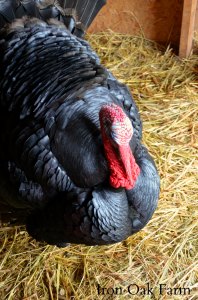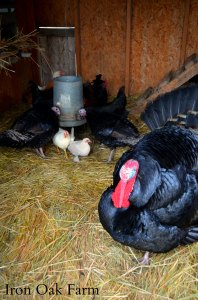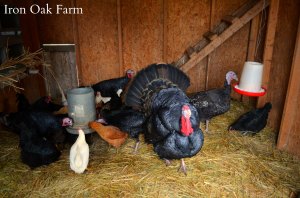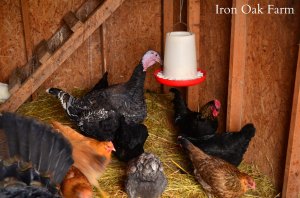
 by Jennifer Sartell of Iron Oak Farm
by Jennifer Sartell of Iron Oak Farm
Raising turkeys is similar to raising chickens in many ways. But when it comes to nutrition requirements, turkeys need different nutrients than chickens to prosper. Turkeys are larger birds, with larger feathers, they lay larger eggs and their feed should support these differences.
For the most part, I feel comfortable with what we feed our turkeys. They are robust, healthy and large for their breed size. Last year we hatched out 3 healthy offspring who have surpassed their parent’s size in just under 6 months!
Our current practice is to feed a 28% Game Feed when they are poults. As they get older, we mix the 28% with a 20% grower. If we plan to slaughter them, they stay on this feed until early November which is when we harvest. If I plan to keep the flock for breeding, I reduce the protein levels to 16% mixed with the 28%. Ideally, they should be switched to a turkey feed made specifically for turkeys, but I haven’t been able to locate a turkey feed at any stores near our home. Once the turkeys are full grown, they no longer need the additional protein, but Game Feed has vitamins and nutrients that are important to a turkey’s health.
 The turkeys also have access to the chicken feed most of the year, which is all at 16%. We raise our turkeys and chickens together during the cooler months. In winter, when the hoses freeze, it makes things easier to haul the buckets of water to the same coop. They are separated again come spring when the turkeys start laying and sitting on eggs.
The turkeys also have access to the chicken feed most of the year, which is all at 16%. We raise our turkeys and chickens together during the cooler months. In winter, when the hoses freeze, it makes things easier to haul the buckets of water to the same coop. They are separated again come spring when the turkeys start laying and sitting on eggs.
 When they are together, we hang the turkey feed higher where the chickens have a hard time reaching it.
When they are together, we hang the turkey feed higher where the chickens have a hard time reaching it.
 Around molting time I throw a scoop or two of the game feed to the chickens. It helps them recover from the molt. I’ve noticed that since we’ve been raising turkeys and have the higher protein feed on hand, that the chicken’s feather grow back much quicker.
Around molting time I throw a scoop or two of the game feed to the chickens. It helps them recover from the molt. I’ve noticed that since we’ve been raising turkeys and have the higher protein feed on hand, that the chicken’s feather grow back much quicker.
Our chickens and turkeys also have access to our 14 acres during the day. Heritage breeds like our Black Spanish adapt well to free range diets, however standard breeds like our Bronze Breasted will have to have supplemental feed.
In the spring, when the turkeys start laying, I offer oyster shell free choice. They also enjoy fresh greens, pumpkin, and extra chicken eggs scrambled.
We do offer grit to both our chickens and turkeys, but because our birds free range, they consume most of their digestible grit from the ground. When they range, they pick up bits of dirt and gravel naturally. This helps break down and digest the food in the gizzard.
 Though I am pleased with our feeding routine, it never hurts to do a little research. I like to double check our practices and make sure we’re caring for our animals in the most healthy way we can provide.
Though I am pleased with our feeding routine, it never hurts to do a little research. I like to double check our practices and make sure we’re caring for our animals in the most healthy way we can provide.
After doing a Google search, I found more articles on feeding wild turkeys than domestic which was interesting. I did find some help over at the American Livestock Breed Conservancy (ALBC).
According to the article How to Raise Heritage Turkeys on Pasture by Jeannette Beranger, Jeff May and Marjorie Bender, “poults need a 28% game feed, growing birds need 20% and breeding adults can be sustained at 17%.” The article goes on to say that “high protein levels in the diet of breeding bird can effect the hatchability of the egg.” ALBC.
Our protein levels are a little higher than what the ALBC recommends, but so far we haven’t seen any problems. Our hatch rate last year was about 80% and I’m happy with that, but I will keep this advice in mind come spring.
Do you raise turkeys? What are your feeding practices? I’d love to hear what works for you. Tell us by leaving a comment below, or visit the Community Chicken’s Facebook Page.













12 Comments
Hi.. I’m looking for affordable pellet food to feed a couple of wild invalid turkeys. They only have one leg each.. Is ‘finisher’ food healthy for them?
Elizabeth,
The finisher feeds should be fine. They do often contain extra protein. This means that I wouldn’t feed them any more protein (such as meal worms). Hope the invalids are doing well.
Dear Turkey Owners,
I would like to recommend a film called, “My Life As A Turkey.” I know that sounds strange. Its a story of a man who starts out with a basket full of turkey eggs and raises them to full grown wild turkeys. It is one of the most interesting nature shows that I have ever seen. It was shown on PBS about a month ago. Your PBS station or Amazon.com might be able to get it for you. Good luck with your turkeys.
We raised our first turkey this year. We purchased him from our farm store and fed wild game feed for the first 2 months. then we housed him with the rooster and fed both chicken pellets. by the middle of November, we realized he was getting big. when we butchered him for thanksgiving…he was a whopping 55 pounds. he was too big to think about breading for next year. did we do something wrong? are domestic turkeys supposed to get that big?
More than likely you bought a commercial hybrid broad-breasted variety. You cannot breed these birds, most are unable to do so because of their obese size, and because they are a hybrid their offspring will not be the same genetics as the parents. These birds are “DESIGNED” to be raised to butcher weight and then butchered. In the future, raise them only to the size you want.
Hey there,
One of the key goals for me is to raise Heritage Breed turkeys (Slates, Lavenders, Red Bourbons, and Lace), not just because they are more aesthetically pleasing to me, but mainly because genetically speaking, they should be ‘closer’ in the genetics, to their wild turkey lineage, than any hybrid breed.
This is a key factor for me, because I view ‘wilder’ breeds as having a better genetic foundation for being healthier right out of the eggs, to being better foragers, being able to process a wider variety of foods better, and being hardier than their hybrid cousins.
Healthier turkeys that are easier keepers is my ultimate goal, and I believe that begins with getting closer to ‘nature’ rather than farther away from her.
Once I sell my home here in Central Wyoming, I plan on relocating to Southeast Alaska, and raise ducks for egg production, Easter Eggers and Araucanas/Americaunas and possibly Marans as ‘specialty egg’ producers, as well as peafowl and turkeys, for meat production and chick sales.
All of my fowl must be able to ‘make a living’ foraging, as costs for feed, medicines, and even basics such as straw/hay, will be quite expensive; hence the local available food sources must be a large part of their diet.
Part of my plan is to grow fodder and raise insects, as well as worms, to be included in their diets, to maintain healthy flocks, so that is why this article was important to me; protein levels, mineral, vitamin issues, all must be considered, and the written source the author included was a nice find as well for me. Kudos to her for that inclusion.
The next hurdle for me will be learning about breeding turkeys, with particular attention to confirmation of fertilization in the eggs, comparatives in hatching success rates between under the hen vs in the incubator, and hen raised vs human raised.
The promulgation of the next generation is key to me, as I shan’t be able to merely just ‘pop on over’ to the ‘local’ feed store each Spring and buy a few turkeys for the coming Fall and perhaps some for breeding ‘next year’.
Sustainability is key, and sound information is key….
We have been feeding our chickens and the turkeys the same. We have a Royal Palm male (Gobbles) and his 5 girls(2 Narragansett, 1 blue slate, 1 bourbon red, 1 royal palm. These girls have started laying an egg a day like the chickens! I’m collecting them because I wonder if they would hatch them and if they did would the babies freeze since it is winter.
Might as well eat the eggs, unless you have an incubator and can raise the poults in a brooder. Winter temperatures will usually kill the eggs before the hen begins to sit, unless she lays in a nest area that is protected from freezing temps.
I’m wondering what the benefit is to keeping your turkeys alive more than one season. Is it because they are heritage breeds and therefore slower to get to a good butchering size?
We bought a half-dozen broad-breasted chicks this past spring and raised them throughout the summer. After calculating feed costs just to help them maintain their size, we weren’t very impressed with the overall cost benefit to our family. Sure, we pasture raised our holiday meals but it was an awful lot of work and food in that short amount of time.
Keeping turkeys for more than a year is for breeding and producing your own future poults to raise. Heritage breeds will grow to butcher weight in one season but can take twice as long as the broad-breasted hybrids.
If you are worried about cost to raise your food you are doing it for the wrong reason. The whole purpose of raising your own food, whether it be animal or plant, is that you avoid chemicals, antibiotics, and hormones that commercially raised contains. A secondary purpose, IF YOU HAVE CHILDREN, is for your kids to experience raising their own food and understanding where it comes from.
I have been raising Turkeys, chickens, pheasants, quail, pigeons, ducks, and geese off and on for 50 years. Turkeys and chickens alike, when free range will devour any “critter” they can catch (mice, reptiles, insects, spiders, slugs, etc.), and relish carion. I never waste money on the high priced high protein feeds. I grow patches of leafy vegetables, alfalfa, and clover (that are high protein and will grow in the winter with limited protection) that I can randomly feed to the birds. As well, I save older birds that die, recover roadkill, table scraps, and gather the left over carcasses from hunting, and either boil them whole or not and hang them from a perch or limb for the birds to pick at at their leisure. Any fly larvae, ants, or carion beetles become added protein and the birds adjust their intake as they need it, just as they do in the wild. When fed this way, they do NOT need the extra nutrients and vitamins that are in processed feeds, just as we humans do not need to take commercial vitamins if we eat a balanced diet. For my young birds I raise soldier fly larvae, duckweed, and I grind scratch to a cornmeal consistency ( I make my own scratch from wheat, corn, black-oil sunflower, and sorghum) that I mix with together. I also feed all of my Galliformes fermented feed, which provides them with pro-biotic bacteria, with a small amount of diatomaceous earth mixed in to provide calcium and act as a natural wormer.
We now have 8 turkeys- 6 Royal Palms and 2 Black Spanish. They have been getting mostly chicken feed, but we will be changing everyone over to 20% flock raiser soon. We hatched 6 poults last year (100%) and now they are growing nicely. Can’t wait til next spring to see all the eggs the girls will be laying!